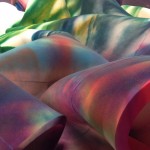Dear Curator,
Please stop making something out of nothing.
Sometimes art is just cool. Sometimes it is colorful. Sometimes it is whimsical. Sometimes it is to shock us, tick us off, or Sometimes it doesn’t need explanation. Sometimes, we can just look at it and say “wow.”
I went to an awesome exhibit in Graz. It was hundreds of square feet of foam, crumbled up, becoming organic like an inchworm, covered in bright spray paint. It was, let’s say, way cool. I could walk around it, photograph it. I knew that when it left this place, it would never be the same. You can’t hang it on your wall. You will never be able to unfurl it just so again. Pretty cool overall. Until I read your pamphlet.
Why must you fill pamphlets with so many words that say so little. Must you feel like the expert? We already know you’re the expert. You commissioned a fantastic work of art. Must you take one sentence and turn it into twenty long sentences? (Trust me, they’re really long.)
You see, I love art. And when you write in your “M.A. in art history” voice, it turns off the public, those who you want to introduce to art. None of us like to feel dumb. None of us like to feel insulted. It’s ok to write to us in 6th grade English. It will make more sense. I understand you have knowledge, but knowledge not understood by the reader is knowledge lost, not knowledge shared.
Sometimes, it’s ok to admit there is no great meaning. Artists create for the aesthetic value, or for the shock value, or just to make some more money. That’s ok. Just don’t try to make it out to be more than it is.
Let’s read your pamphlet together, and I will help you edit:
You wrote: “When Katharina Grosse paints, she dons a protective suit and a face mask; she looks like a laboratory worker, a decontamination expert or an astronaut shaping a strange planet. The suit and her painting tools create distance; the compressor provides the freedom of large-scale movement no matter what she applies the paint to. The spray gun means that Grosse does not need to touch the material on which she paints and hence avoids the classic flow, but it makes possible intensive gestures and sweeping lines which clearly bear the mark of the artist’s hand. Wherever her eye falls, the paint can land.
Here is what you should have said:
“Grosse paints with a spray gun while wearing a full protective suit. This suit keeps her safe from the paint fumes.” Or you could just show a photo of her painting.
You wrote:
“When she starts to spray, Katharina Grosse works alone and in seclusion. The act of creating is something very private, taking place in the uninterrupted rhythm of her movement. Reception turns this introverted creation into a grand extroverted gesture; the performative flow becomes visible in the viewing of her work and the zones of pure colour sensation arise.
Here is what you should have said:
“She likes to paint alone with just her spray gun and her art.”
Finally, you wrote:
“Katharina Grosse uses color obsessively, passionately, impulsively, sometimes also aggressively. The pure colour is of fundamental importance; she tends towards an enormous dynamic, creates moods and is experienced differently depending on the individual viewer’s state of mind.” Blah blah blah.
I get it. She likes colors. I see that. Make it interactive. Put a poster on the wall. Have each of us write down what the art reminds us of. Engage us. We paid money to be here. We want to be engaged, not insulted.
Thank you.
(My previous “Dear Curator” article tackled a similar topic more sarcastically and less crankily.)

